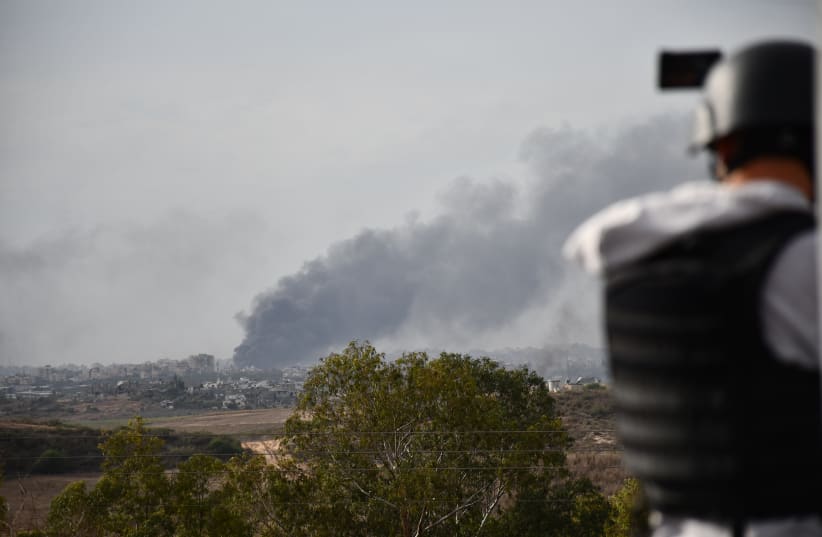Smoke billowed from northern Gaza neighborhoods on Wednesday as Israel and Hamas prepared for a ceasefire. Numerous areas in northern Gaza were still centers of fighting. The smoke could be seen from Sderot and also highways around Ashkelon. It looked like southern Israel was on fire.
It was thick black smoke – and also white smoke caused by explosions from artillery shells. In addition, flares hung in the air. A helicopter hovered overhead.
I went down to Sderot on the eve of the ceasefire to conduct interviews with an IDF unit. After the interviews, I drove to an area in Sderot which has been set aside for journalists.
Sderot was one of the targets of the Hamas attack on October 7. On that dark day, Hamas drove into the city with a pickup truck and other vehicles full of terrorists. They waylaid cars and massacred unsuspecting civilians early in the morning. Then they attacked the police station.
A friend of mine who arrived in Sderot early on October 7 saw bodies in the streets. At first, he called me and said he saw terrorists who had been killed. Then he caught himself and wondered aloud, maybe they were victims of the terrorists. I was near Sderot on the first day of the war as well, on a road near Yad Mordechai. I spent October 8 near Netiv Ha’asara and Zikim. Many bodies were visible on the road that day.
Terrorists were neutralized near Zikim on October 8 – some of the remains of those who had attacked the South on October 7. I saw two of their bodies eviscerated on a road, near a van that was still running. Later I saw reservists in Merkava tanks arrive and shell Gaza.
Every week since then has brought new developments in the war.
Israeli police recounted how they fought the terrorists on October 7 and retook Sderot. Over the next two nights elite police squads hunted down infiltrators between Sderot and Yad Mordechai. In kibbutz Be’eri, members of the Golani battalions who had fought Hamas told their stories of the first day of battle. The kibbutz had suffered grievously, including more than 100 civilians killed.
As the front stabilized, the fields filled with armored vehicles and on October 27 Israel began to surge into Gaza with a ground operation.
Communities around Gaza were almost deserted
By this time all these border communities near Gaza had been evacuated. Sderot residents went to hotels. Many young men mobilized for war. Journalists gathered in the location set aside for them to overlook Gaza. At night the fighting could be heard clearly. Airstrikes made the earth shake. During the day the fighting often diminished. But the fighting went on for three weeks in Gaza until the ceasefire was set to take hold.
Southern Israel near Gaza is full of evidence of the war, from military vehicles to shrapnel from Iron Dome interceptions of rockets from Gaza. Rocket fire has declined.
However, on Wednesday, as I stood overlooking the fighting, two interceptors were launched. The interceptors are launched quickly, to confront threats that only take 15 seconds to get to Sderot. The sirens began wailing after the interceptors flew overhead. It was too late to run for cover. The interceptions had already occurred. Puffs of smoke over our heads.
Sderot isn’t quite as deserted as it was weeks ago. However, in general, the city feels like a ghost town. There is a lot of traffic to and from the city, though, mostly civilian cars. Life is returning slowly, tip-toeing back to these areas.
As journalists watched the fighting on Wednesday, a dove, or a white pigeon, landed on a railing. One by one the journalists gathered around it, sensing its presence somehow heralded peace. The bird seemed almost tame, wandering around among the people who were bemused and fascinated by its presence. Then it wandered off, and the journalists turned back to watch the black smoke billowing out of Gaza.

